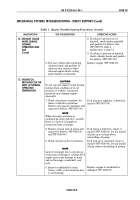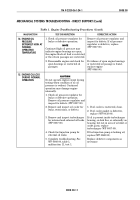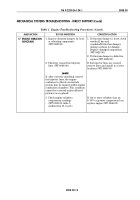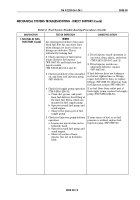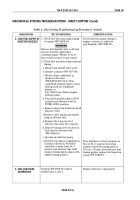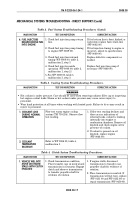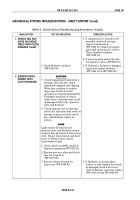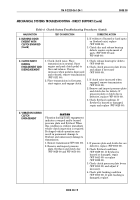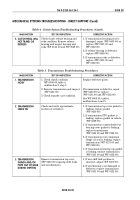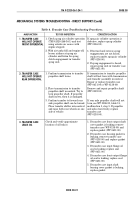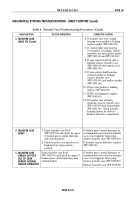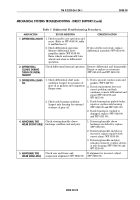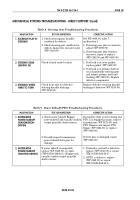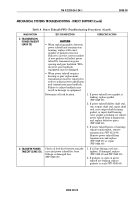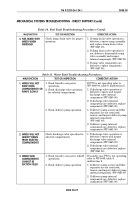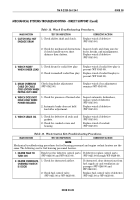TM-9-2320-361-24-1 - Page 147 of 1176
TM 9-2320-361-24-1
0008 00
0008 00-19
MECHANICAL SYSTEMS TROUBLESHOOTING - DIRECT SUPPORT (Contd)
MALFUNCTION
TEST OR INSPECTION
CORRECTIVE ACTION
2. BURNING ODOR
EVIDENT WITH
CLUTCH ENGAGED
(Contd)
2. If evidence of burned or hard spots
on flywheel exist, replace
(WP 0029 00).
3. Clutch disc and release bearing
defects require replacement of
parts (WP 0050 00 and
WP 0049 00).
3. CLUTCH NOISY
DURING
ENGAGEMENT AND
DISENGAGEMENT
1. Check clutch noise. Place
transmission in neutral. Start
engine and push clutch pedal to
floor and release. If noise
increases when pedal is depressed
and released, remove transmission
(WP 0131 00).
2. Place transmission in first gear,
start engine, and engage clutch.
1. Check release bearing for defects
(WP 0049 00).
2. Check clutch pressure plate levers
and adjust if necessary
(WP 0050 00).
1. If clutch noise increased when
engaged, remove transmission
(WP 0131 00).
2. Remove and inspect pressure plate
and clutch disc for defects. If
pressure plate or clutch disc is
defective, replace (WP 0050 00).
3. Check flywheel condition. If
flywheel is burned or damaged,
repair and replace (WP 0029 00).
4. VIBRATION DURING
CLUTCH
ENGAGEMENT
CAUTION
Vibration during clutch engagement
indicates a warped and/or burned
pressure plate and flywheel. When
this condition is evident, immediate
vehicle clutch inspection is required.
Prolonged vehicle operation may
result in permanent damage to
flywheel and unnecessary damage to
transmission.
1. Remove transmission (WP 0131 00).
2. Remove and inspect pressure
plate, flywheel, and clutch disc
(WP 0029 00 and WP 0050 00).
1. If pressure plate and clutch disc are
defective, replace (WP 0050 00).
2. Check flywheel conditions
(WP 0029 00). If flywheel is
burned or damaged, repair
(WP 0441 00) or replace
(WP 0029 00).
3. Check clutch pressure plate levers
(WP 0050 00) and adjust if
necessary.
4. Check pilot bushing condition
(WP 0050 00). If pilot bushing is
damaged, replace.
Table 4. Clutch System Troubleshooting Procedures (Contd).
Back to Top

